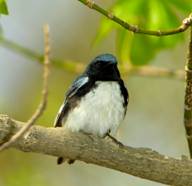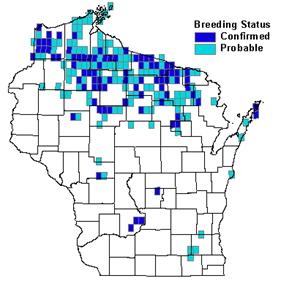Photo by Dennis Malueg


Status/Protection
- Global Rank: G5 Key to global and state ranks
- State Rank: S3B
- WBCI Priority: SGCN, PIF, State Special Concern
Population Information
Federal BBS information can be obtained at http://www.mbr-pwrc.usgs.gov/bbs/bbs.html by clicking on Trend Estimates and selecting the species in question. All estimates are for 1966-2005.
*Note: There are important deficiencies with these data. These results may be compromised by small sample size, low relative abundance on survey route, imprecise trends, and/or missing data. Caution should be used when evaluating this trend.
- Federal Breeding Bird Survey: non-significant increase
- Federal Breeding Bird Survey (WI): non-significant increase*
- Federal Breeding Bird Survey (BCR 23): non-significant increase*
- Federal Breeding Bird Survey (BCR 12): non-significant increase
- Nicolet National Forest Bird Survey (UWGB): significant decline (Howe and Roberts 2005)
- WSO Checklist Project: stable (1983-2007)
Life History
- Breeding Range: Southern Ontario east across southern Canada and northeastern U.S. to Atlantic Coast, extending south into Appalachian Mountains (Holmes 1994).
- Breeding Habitat: Northern Hardwood, mature deciduous/coniferous forests with well-developed understory.
- Nest: Cup, usually less than 1 meter above ground (Ehrlich et al. 1988, Holmes 1994).
- Nesting Dates: Eggs: June (WSO 1995); mid-May to mid-August elsewhere in N. America (Holmes 1994).
- Foraging: Hover and glean, foliage glean, hawks.
- Migrant Status: Neotropical migrant.
- Habitat use during Migration: Forest edge, wooded riparian areas, gardens and parks.
- Arrival Dates: Early May (Robbins 1991).
- Departure Dates: August to early October (Robbins 1991).
- Winter Range: Primarily West Indies (DeGraaf and Rappole 1995); occasional along Caribbean coast of Yucatan to Honduras (Holmes 1994).
- Winter Habitat: Dense tropical woodlands and forests ranging from sea level to high elevations (Holmes 1994).
Habitat Selection
The Black-throated Blue Warbler breeds primarily in large tracts of mature deciduous or mixed deciduous/coniferous forests with a well-developed understory (Holmes 1994). In Wisconsin it favors upland forests of maple or mixed northern hardwoods (Howe 2006). Robbins et al. (1989) listed this species as area-sensitive, occurring mainly in forest tracts >100 ha. Several authors have found Black-throated Blue Warblers to be tolerant of certain silvicultural systems. Jobes et al. (2004) found similar abundances in unharvested reference stands and stands subjected to recent selection cutting (1-5 years), but lower abundance in stands harvested 15-20 years prior. The significant increase in shrub density shortly after selection harvest likely contributed to the higher abundances. Harris and Reed (2002) documented a variety of responses to clearcut edge and forest interior sites, including some positive correlations to edge sites. Pairing success was higher near edges, where understory density was significantly greater. Furthermore, there was no apparent net difference in the probability that a male establishing a territory at an edge or interior site would produce fledglings. However, response to edge will vary depending on the landscape in which the edge is embedded.
Nests are placed in a dense understory of shrubs and saplings, usually within 1-1.5 meters of the ground. Doran and Holmes (2005) characterized high quality nesting sites as those with a greater proportion of deciduous vegetation and denser understory than surrounding sites. Within the contiguous forested landscape of this study, there was significant intraspecific spatial variation in bird abundance. The majority of individuals were found in relatively few locations across the landscape. Hoffman (unpubl. data) also documented a disproportionately high occupancy rate at one site in northern Wisconsin. Six territorial males were present within a 2-ha unsalvaged blowdown in old-growth forest.
Habitat Availability
In Wisconsin the Black-throated Blue Warbler occurs primarily in the northern region of the state (Robbins 1991). Prior to Euro-American settlement, the northern mesic forest covered the largest acreage of any Wisconsin vegetation type. Today this forest type is still very extensive, but fragmentation of contiguous blocks and the simplification of forest structure and composition are concerns. Many mature and old-growth stands have been replaced by second-growth forests of aspen, white birch, sugar maple, and red maple (WDNR 2005).
Population Concerns
Breeding Bird Survey data suggest non-significant increases for this species; however, these results are difficult to interpret due to small sample sizes (Sauer et al. 2005). Contradictory results from the Nicolet National Forest Bird Survey (1987-2001) suggest significant population declines (Howe and Roberts 2005). Due to the rarity of the Black-throated Blue Warbler in Wisconsin, increased BBS coverage or targeted survey efforts are likely required to obtain a true assessment of its status. During the six-year period (1995-2000) of the Wisconsin Breeding Bird Atlas, observers confirmed breeding in just 2% of the surveyed quads (Howe 2006).
Limiting factors for the Black-throated Blue Warbler are poorly known. Wisconsin is near the western edge of this species’ breeding range (Robbins 1991), thus it has likely never been common within the state. Loss or fragmentation of large blocks of older, structurally complex forests may negatively impact this species. Overbrowsing by deer may suppress populations locally by reducing the shrub layer available for nesting (WDNR 2005). Loss of habitat on the wintering grounds in the West Indies also is suggested as a possible limiting factor (Holmes 1994).
Recommended Management
Management efforts for this species should focus on maintaining large blocks of mature forest with patches of vertical complexity (WDNR). Management practices that promote a well-developed shrub understory also will benefit this species. This includes providing canopy gaps through single tree and group selection harvest practices in northern hardwood stands (Jobes et al. 2004) and retaining balsam fir within managed stands.
Conservation and management strategies for this species should be focused in the following Wisconsin ecological landscapes: North Central Forest, Northern Highland, Northern Lake Michigan Coastal, and Superior Coastal Plain (WDNR 2005). Within these landscapes, key conservation sites include the Chequamegon-Nicolet National Forest in Ashland and Bayfield counties, Penokee Range IBA in Iron County, and Plum Lake Hemlock Forest State Natural Area in Vilas County.
Research Needs
In Wisconsin, studies investigating the response to different silvicultural treatments would help guide future management efforts. Additionally, the potential impacts of deer browsing warrants study (WDNR 2005). Habitat-specific demography in the winter has not been adequately examined (Holmes 1994). More information is needed regarding the wintering distribution of specific populations.
Information Sources
- Chequamegon National Forest Bird Survey (NRRI) species account: http://www.nrri.umn.edu/mnbirds/accounts/BTBWa2.htm
- Great Lakes Bird Conservation probability map: http://www.uwgb.edu/birds/greatlakes/species/btbwmap2.htm
- Nicolet National Forest Bird survey map: http://www.uwgb.edu/birds/nnf/species/BTBW.htm
- North American Breeding Bird Survey: http://www.mbr-pwrc.usgs.gov/bbs/bbs.html
- Temple S.A., J.R. Cary, and R. Rolley. 1997. Wisconsin Birds: A Seasonal and Geographical Guide. Wisconsin Society of Ornithology and Wisconsin Department of Natural Resources, Madison, WI.
- Wisconsin Breeding Bird Atlas: http://www.uwgb.edu/birds/wbba/
- R.T. Holmes, Dept. of Biological Sciences, Dartmouth College, Hanover, NH; richard.t.holmes@dartmouth.edu.
References
- DeGraaf, R.M., and J.H. Rappole. 1995. Neotropical migratory birds: natural history, distribution, and population change. Comstock Publ. Assoc., Cornell Univ. Press, Ithaca, NY.
- Doran, P. J. and R.T. Holmes. 2005. Habitat occupancy patterns of a forest dwelling songbird: causes and consequences. Canadian Journal of Zoology 83(10): 1297-1305.
- Ehrlich, P.R., D.S. Dobkin, and D. Wheye. 1988. The birders handbook: a field guide to the natural history of North American birds. Simon & Schuster, Inc. New York.
- Harris, R.J. and J.M. Reed. 2002. Effects of forest-clearcut edges on a forest-breeding songbird. Canadian Journal of Zoology 80(6): 1026-1037.
- Hoffman, R.M. 2003. Conservation Biologist, Wisconsin Department of Natural Resources. 608-267-7758.
- Holmes, R.T. 1994. Black-throated Blue Warbler (Dendroica caerulescens). In The Birds of North America, No. 87. Academy of Natural Sciences, Philadelphia, PA, and the American Ornithologists’ Union, Washington, D.C.
- Howe, B. 2006. Black-throated Blue Warbler. In Atlas of the Breeding Birds of Wisconsin. (N.J. Cutright, B.R. Harriman, and R.W. Howe, eds.) The Wisconsin Society for Ornithology, Inc. 602pp.
- Howe, R.W. and L.J. Roberts. 2005. Sixteen years of habitat-based bird monitoring in the Nicolet National Forest. In C.J. Ralph and T.D. Rich, editors. Bird Conservation Implementation and Integration in the Americas: Proceedings of the Third International Partners in Flight Conference. 2002 March 20-24; Asilomar, California, Volume 2. Gen. Tech. Rep. PSW-GTR-191. Albany, CA: Pacific Southwest Research Station, Forest Service, U.S. Department of Agriculture. 643 p.
- Jobes, A.P., E. Nol, and D.R. Voigt. 2004. Effects of selection cutting on bird communities in contiguous eastern hardwood forests. Journal of Wildlife Management 68(1): 51-60.
- Robbins, S.D. 1991. Wisconsin birdlife: population & distribution, past & present. Univ. of Wisconsin Press, Madison, WI.
- Sauer, J.R., J.E. Hines, and J. Fallon. 2005. The North American Breeding Bird Survey, Results and Analysis 1966 - 2005. Version 6.2.2006. USGS Patuxent Wildlife ResearchCenter, Laurel, MD.
- Wisconsin Department of Natural Resources (WDNR). 2005. Wisconsin’s Strategy for Wildlife Species of Greatest Conservation Need. Madison, WI.
- Wisconsin Society for Ornithology (WSO). 1995. Wisconsin breeding bird atlas: atlasing handbook 1995-1999. Wisconsin Society for Ornithology, Inc., Hartland, WI.
Contact Information
- Compiler: William P. Mueller, iltlawas@earthlink.net
- Editors: Kim Kreitinger, K.Kreitinger@gmail.com | Randy Hoffman, Randolph.hoffman@Wisconsin.gov
